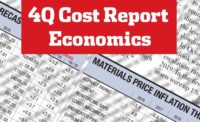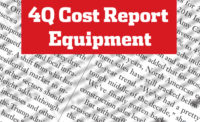Q4 Cost Report: Tariff Issues, Cost Increases Show Few Signs of Ending in 2019

The appointment of U.S. Trade Representative Robert Lighthizer, seen as a trade hardliner, as lead negotiator on China trade talks was a surprise to some industry officials.
PHOTO: CHIP SOMODEVILLA/PICTURE-ALLIANCE/DPA/AP IMAGES
Tariff costs are mounting for construction companies, and there’s no sign of much relief in the new year. Tariff collections totaled over $5 billion in October, according to data from the U.S. Treasury Dept. and the U.S. Census Bureau. The amount being paid has doubled since May as tariffs were applied to a growing group of countries, and exemptions expired for projects that began before the new levies were imposed.
Between August and October, tariffs rose 30%, with October the first full month in which the penalties were placed on $250 billion worth of Chinese imports.
A 90-day truce between the U.S. and China began Dec. 1, with the U.S. delaying a planned Jan. 1 tariff hike until March 2 and, according to Reuters, China rolling back its tariff on U.S.-built vehicles to the 15% global rate put in place in May. But there’s still no deal between the world’s two largest trading partners, and existing tariffs remain in place. Also, the Trump Administration named as lead China negotiator U.S. Trade Representative Robert Lighthizer, who is seen by the markets as a trade hardliner. A trade pact is anything but assured, observers say.
“The choice of Robert Lighthizer to be the negotiator is a signal that Trump isn’t going to budge,” says Ken Simonson, chief economist of the Associated General Contractors of America. “It’s normal that the U.S. trade representative would be the person to conduct this negotiation, but I think some people may have assumed that maybe there would be a more moderate or mixed panel to do it.”
All contractors are paying more for steel but how much, exactly, depends on the individual buyer. The U.S. Bureau of Labor Statistics’ producer price index for steel mill products—which covers construction, automotive and other steel-use manufacture—is up 18% from October 2017 to October 2018. With the exemptions expiring for projects that began the procurement process before the original steel tariffs were imposed in March, Simonson says that number is likely to go up in 2019.
Since tariffs are only on milled steel, fabricated steel products are not facing a penalty, and fabricators in other countries are taking advantage. The American Institute of Steel Construction says that fabricated steel imports from Mexico increased by 40% this year, and the imports from Canada are up 20%.
There are no fabricated structural steel products in the new $250 billion in tariffs against China, says Brian Raff, AISC director of government relations. Even so, the association that represents U.S. steel fabricators does not expect closure on a China deal any time soon. “We haven’t had any public indication from anyone in the administration on where these [tariffs] are going to go and when,” Raff says.
Even with a new trade deal agreed to by the U.S., Mexico and Canada, tariffs on milled products and aluminum remain on those neighboring countries. Despite these increased costs, however, contractors are still enjoying strong demand for their services.
“Our index that we do internally here matches pretty closely with what ENR has done,” says Trent Wachsnicht, senior vice president and group estimating manager at JE Dunn Construction. “We’re seeing overall costs that have grown in that 5% range for the year, and we think that’s pretty close to what you’d expect, as hot as the market is.” He adds, “I don’t think it’s been anything out of the unexpected range. We’ll see marginal increases but nothing major. I think people have calmed down and learned how to navigate around this, at least the original steel and aluminum tariffs.” But Wachsnicht cautions that “Chinese tariffs are still something in flux.”
Wachsnicht said that JE Dunn has relied on its multisource procurement and supply-chain management process to mitigate increased costs, and firm managers don’t envision any more tariffs on Chinese products having as big an impact as Section 201 (of the 1974 Trade Act) tariffs on aluminum and steel.
|
Related Link |
Pushing Prices
The producer price index for all construction inputs (an index of everything from materials to diesel fuel) rose 6.6% from October 2017 to October 2018. The U.S. Bureau of Labor Statistics also releases an hourly earnings index, which includes wages and salaries for all construction employees, which went up 3.9% over that same period. The producer price index for new non-residential buildings is a survey in which BLS each month asks the same set of contractors questions like what they would charge to erect a certain type of building with certain specifications. That index has increased 5% from October 2017 to October 2018.
“Basically, contractors seem to be pushing prices a little ahead of their labor costs, but they’re not keeping up with their input costs of materials and services,” says Simonson. “So, they need to be achieving some productivity savings, or else they’re going to have their margins squeezed when they go to buy these goods and services.”
Many contractors have substituted concrete instead of steel where they can to save on costs, such as using reinforced concrete pilings instead of steel ones. There is rebar in concrete pilings, but far less than in steel pilings. Others are employing a revised exclusion process that allows them to apply for tariff exemptions through the U.S. Commerce Dept. for steel products that are too costly or unavailable in an area.
With switching to concrete not an option for specialty steel contractors, U.S. Metal Partners International, an Aurora, Ill., rebar fabricator and detailer, says it has seen its prices increase by more than $3 million since May. The firm still awaits the outcome of its exclusion request.
On the supply side, U.S. manufacturers of steel and aluminum are recording their strongest profits in years, thanks to the tariffs. Fort Wayne, Ind.-based Steel Dynamics said in late November that it will build a $1.7-billion flat-rolled steel mill with an electric-arc furnace somewhere in the Southwest.
The project will not begin construction until at least 2020, but the firm—which reported a record $531 million in operating income in its third-quarter filing in September—promises to employ 600 workers at the plant and create construction, automotive and manufacturing products there.
The tariffs are driving down imports. Based on the U.S. Commerce Dept.’s most recent steel import monitoring and analysis data from the American Iron and Steel Institute (AISI), for the first 10 months of 2018, total steel imports fell 10%, to about 32 million net tons, and finished steel fell 13.3%, to 24 million net tons, from their 2017 levels. Shipments from U.S. steel mills through October were 79.64 million net tons, a 4.6% increase compared to 76.13 million net tons through the first 10 months of 2017.
U.S. steel advocacy group AISI praised the Administration for the U.S.-Mexico-Canada trade agreement, which still must be ratified by legislative bodies in all three countries despite tariffs remaining in place on imports from both neighboring countries.




